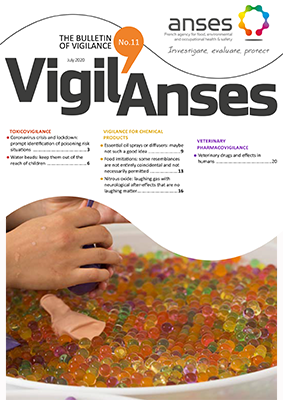Issue 11 OF VIGIL'ANSES
Editorial

The first article in this issue of Vigil'Anses looks back at the alert issued by ANSES on 30 March 2020 in the midst of the lockdown due to the coronavirus, concerning risky behaviour in terms of disinfection of homes, food and even the body, due to the use of inappropriate products or under conditions that do not comply with the recommendations. The article presents an analysis of the cases observed by French poison control centres between 1 and 24 March 2020.
Another article reports calls to poison control centres related to the use of essential oil-based sprays and diffusers used to clean indoor air. Although most often mild, adverse effects such as eye or throat irritations or even breathing difficulties have been observed, even when the products are used as recommended. They should therefore be used with caution by people with a history of respiratory problems. These products should also be kept out of reach of children, as demonstrated by some of the accidents reported here.
Among the hazards at home for very young children are water beads – increasingly used for decoration, water plants or even as toys – because of their potential to swell up to several hundred times their dry volume once hydrated. Mistaken for sweets and swallowed by young children, these super-absorbent polymers can cause small bowel obstructions, as reported in the third article in this issue of Vigil'Anses.
Everyday products packaged to look like food pose a real hazard to children: biscuit-shaped soaps, candles in the shape of sweets, etc. The fourth article in this issue presents the European regulation on food imitations, which protect users from the risks associated with these products, giving a few examples. It is important to report products that deviate from this regulation, to ensure that they can be withdrawn from the market!
The inhalation of nitrous oxide or laughing gas contained in gas cartridges used in whipped cream siphons has become an increasingly common recreational practice, especially because these products are freely available in large quantities, in shops or on the Internet. Unfortunately, consumers know little about the observed toxic effects, which can sometimes be serious, as shown in the fifth article in this issue.
Lastly, the final article in this issue presents the 2018 report of adverse effects observed in humans after exposure to a veterinary medicinal product, whether accidental or intentional, recorded by the veterinary pharmacovigilance scheme. It underlines the importance of reporting these adverse effects, whether to a poison control centre or through the reporting portal, in order to identify the preventive measures to be taken.
Juliette Bloch, Editor-in-Chief of Vigil'Anses

